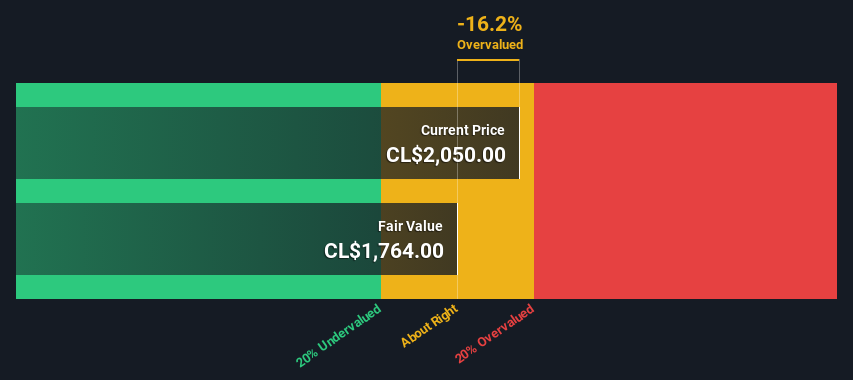- Chile
- /
- General Merchandise and Department Stores
- /
- SNSE:FALABELLA
Estimating The Intrinsic Value Of Falabella S.A. (SNSE:FALABELLA)

Key Insights
- Falabella's estimated fair value is CL$1,764 based on 2 Stage Free Cash Flow to Equity
- Falabella's CL$2,050 share price indicates it is trading at similar levels as its fair value estimate
- Our fair value estimate is 16% lower than Falabella's analyst price target of CL$2,092
How far off is Falabella S.A. (SNSE:FALABELLA) from its intrinsic value? Using the most recent financial data, we'll take a look at whether the stock is fairly priced by taking the expected future cash flows and discounting them to today's value. This will be done using the Discounted Cash Flow (DCF) model. Don't get put off by the jargon, the math behind it is actually quite straightforward.
We generally believe that a company's value is the present value of all of the cash it will generate in the future. However, a DCF is just one valuation metric among many, and it is not without flaws. For those who are keen learners of equity analysis, the Simply Wall St analysis model here may be something of interest to you.
View our latest analysis for Falabella
The Model
We are going to use a two-stage DCF model, which, as the name states, takes into account two stages of growth. The first stage is generally a higher growth period which levels off heading towards the terminal value, captured in the second 'steady growth' period. To start off with, we need to estimate the next ten years of cash flows. Seeing as no analyst estimates of free cash flow are available to us, we have extrapolate the previous free cash flow (FCF) from the company's last reported value. We assume companies with shrinking free cash flow will slow their rate of shrinkage, and that companies with growing free cash flow will see their growth rate slow, over this period. We do this to reflect that growth tends to slow more in the early years than it does in later years.
Generally we assume that a dollar today is more valuable than a dollar in the future, and so the sum of these future cash flows is then discounted to today's value:
10-year free cash flow (FCF) forecast
| 2024 | 2025 | 2026 | 2027 | 2028 | 2029 | 2030 | 2031 | 2032 | 2033 | |
| Levered FCF (CLP, Millions) | CL$661.3b | CL$610.8b | CL$593.6b | CL$596.9b | CL$614.3b | CL$642.4b | CL$679.2b | CL$723.5b | CL$774.9b | CL$833.0b |
| Growth Rate Estimate Source | Est @ -14.51% | Est @ -7.63% | Est @ -2.81% | Est @ 0.56% | Est @ 2.92% | Est @ 4.57% | Est @ 5.72% | Est @ 6.53% | Est @ 7.10% | Est @ 7.49% |
| Present Value (CLP, Millions) Discounted @ 19% | CL$557.1k | CL$433.6k | CL$355.0k | CL$300.8k | CL$260.8k | CL$229.8k | CL$204.7k | CL$183.7k | CL$165.7k | CL$150.1k |
("Est" = FCF growth rate estimated by Simply Wall St)
Present Value of 10-year Cash Flow (PVCF) = CL$2.8t
After calculating the present value of future cash flows in the initial 10-year period, we need to calculate the Terminal Value, which accounts for all future cash flows beyond the first stage. For a number of reasons a very conservative growth rate is used that cannot exceed that of a country's GDP growth. In this case we have used the 5-year average of the 10-year government bond yield (8.4%) to estimate future growth. In the same way as with the 10-year 'growth' period, we discount future cash flows to today's value, using a cost of equity of 19%.
Terminal Value (TV)= FCF2033 × (1 + g) ÷ (r – g) = CL$833b× (1 + 8.4%) ÷ (19%– 8.4%) = CL$8.8t
Present Value of Terminal Value (PVTV)= TV / (1 + r)10= CL$8.8t÷ ( 1 + 19%)10= CL$1.6t
The total value, or equity value, is then the sum of the present value of the future cash flows, which in this case is CL$4.4t. The last step is to then divide the equity value by the number of shares outstanding. Compared to the current share price of CL$2.1k, the company appears around fair value at the time of writing. The assumptions in any calculation have a big impact on the valuation, so it is better to view this as a rough estimate, not precise down to the last cent.

The Assumptions
We would point out that the most important inputs to a discounted cash flow are the discount rate and of course the actual cash flows. You don't have to agree with these inputs, I recommend redoing the calculations yourself and playing with them. The DCF also does not consider the possible cyclicality of an industry, or a company's future capital requirements, so it does not give a full picture of a company's potential performance. Given that we are looking at Falabella as potential shareholders, the cost of equity is used as the discount rate, rather than the cost of capital (or weighted average cost of capital, WACC) which accounts for debt. In this calculation we've used 19%, which is based on a levered beta of 1.636. Beta is a measure of a stock's volatility, compared to the market as a whole. We get our beta from the industry average beta of globally comparable companies, with an imposed limit between 0.8 and 2.0, which is a reasonable range for a stable business.
SWOT Analysis for Falabella
- Debt is well covered by cash flow.
- Interest payments on debt are not well covered.
- Current share price is above our estimate of fair value.
- Expected to breakeven next year.
- Has sufficient cash runway for more than 3 years based on current free cash flows.
- No apparent threats visible for FALABELLA.
Looking Ahead:
Although the valuation of a company is important, it ideally won't be the sole piece of analysis you scrutinize for a company. It's not possible to obtain a foolproof valuation with a DCF model. Rather it should be seen as a guide to "what assumptions need to be true for this stock to be under/overvalued?" If a company grows at a different rate, or if its cost of equity or risk free rate changes sharply, the output can look very different. For Falabella, there are three essential aspects you should look at:
- Risks: To that end, you should learn about the 2 warning signs we've spotted with Falabella (including 1 which is concerning) .
- Future Earnings: How does FALABELLA's growth rate compare to its peers and the wider market? Dig deeper into the analyst consensus number for the upcoming years by interacting with our free analyst growth expectation chart.
- Other Solid Businesses: Low debt, high returns on equity and good past performance are fundamental to a strong business. Why not explore our interactive list of stocks with solid business fundamentals to see if there are other companies you may not have considered!
PS. Simply Wall St updates its DCF calculation for every Chilean stock every day, so if you want to find the intrinsic value of any other stock just search here.
New: AI Stock Screener & Alerts
Our new AI Stock Screener scans the market every day to uncover opportunities.
• Dividend Powerhouses (3%+ Yield)
• Undervalued Small Caps with Insider Buying
• High growth Tech and AI Companies
Or build your own from over 50 metrics.
Have feedback on this article? Concerned about the content? Get in touch with us directly. Alternatively, email editorial-team (at) simplywallst.com.
This article by Simply Wall St is general in nature. We provide commentary based on historical data and analyst forecasts only using an unbiased methodology and our articles are not intended to be financial advice. It does not constitute a recommendation to buy or sell any stock, and does not take account of your objectives, or your financial situation. We aim to bring you long-term focused analysis driven by fundamental data. Note that our analysis may not factor in the latest price-sensitive company announcements or qualitative material. Simply Wall St has no position in any stocks mentioned.
About SNSE:FALABELLA
Falabella
Engages in the retail sale of clothing, accessories, home products, electronics, and beauty and other products in Chile, Peru, Colombia, Brazil, Mexico, Uruguay, and Argentina.
Moderate growth potential with mediocre balance sheet.

